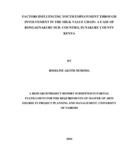| dc.description.abstract | Youth unemployment is a widespread phenomenon in the world. The case is much worse in Kenya. Today, Kenya's youth unemployment rate stands at 67 percent, among the highest in the world. The purpose of this study was to examine the factors that influence youth employment through involvement in the milk value chain in Rongai/Nakuru sub-counties, in Nakuru County, Kenya. The study was based on the following objectives: i) To establish how demographic characteristics of the youths influence their involvement in the milk value chain in Rongai/Nakuru sub-counties: ii) To determine how marketing factors influence youth involvement in the milk value chain in Rongai/Nakuru sub counties: iii) To establish how youth awareness on dairy activities influence their involvement in the milk value chain in Rongai/Nakuru sub-counties: iv) To establish how economic factors influence youth involvement in the milk value chain in Rongai/Nakuru sub-counties. A literature review on the world dairy industry, Kenya dairy sector, milk production in Kenya, Market structure, youth unemployment, Demographic characteristics, theoretical framework, conceptual framework and knowledge gap has been discussed in details. A qualitative survey was conducted by randomly selecting 247 youth actors in the milk value chain in Nakuru and Rongai sub counties in Nakuru County. Data was collected using structured questionnaires and analyzed using Statistical Packages for social Scientists (SPSS). The findings are presented in tables and summaries will be inferred on the whole population. The results from the study indicate that majority of the youth involved in the milk value chain were married and had at least secondary school level of education, and 56.5% were between 26-35 years of age implying very active. They had low access to low interest funds limiting their capacity to invest. Due to the shortage of funds and skills 92% of the respondents were at the production and trading level of the chain. Very low value addition to milk produced or delivered to the market was done and this left the youth exposed to high risks of loses during the pick season. The training offered is mainly by the government agency which the respondents rated low in terms of quality therefore the youths are not updated to enable them handle the various challenges in the industry. Access to information for majority of the respondents was mainly through sharing with colleagues, which means it is not ascertained information and may mislead. The land ownership was mainly through inheritance and they did not have title deeds they could use to secure funds. The sizes of land are low with majority owning less than two acres of land, this limits their output and thus low profit margins per month which are less than KSH. 10,000 for majority of the respondents. The study recommends more research to be carried out on the factors influencing dissemination and access of information among the youth, factors hindering them to join economic groups and policies that need review in the sector. | en_US |

